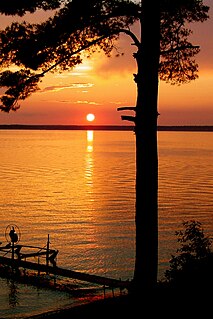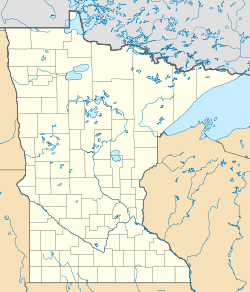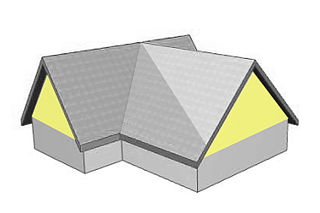
Disney's Wilderness Lodge is a AAA Four-Diamond Award–winning resort hotel located at the Walt Disney World Resort. It opened on May 28, 1994. The resort is owned and operated by Disney Parks, Experiences and Products. Disney's Wilderness Lodge is located in the Magic Kingdom Resort Area on Bay Lake. The resort is also located near Disney's Fort Wilderness Resort & Campground. A similarly-themed resort, Disney's Grand Californian Hotel & Spa, is located at the Disneyland Resort in California.

The Fairmont Le Château Montebello, formerly and commonly known as the Château Montebello, is a historic hotel and resort complex in Montebello, Quebec, Canada. The resort features a large game reserve, as well as claims to be the largest wooden structure in the world. The wooden hotel structure was developed by Victor Nymark.

The Lake McDonald Lodge Historic District is a historic district in Glacier National Park in the U.S. state of Montana. It comprises the Lake McDonald Lodge and surrounding structures on the shores of Lake McDonald. It is centered on the main lodge, which was designated a National Historic Landmark in 1987, as well as surrounding guest cabins, dormitory buildings, employee residences, utility buildings, and retail structures. The district includes several privately owned inholding structures that are contributing structures, as well as a number of non-contributing buildings.

Pine Mountain State Resort Park is a Kentucky state park located in Bell County, Kentucky, United States. The park opened in 1924 as Kentucky's first state park. Each spring, the park hosts the annual Kentucky Mountain Laurel Festival, as it has since 1933. A portion of the park is also a legally dedicated nature preserve by the Office of Kentucky Nature Preserves.

Burntside Lodge is a resort located on the southern shore of Burntside Lake, several miles out of Ely, Minnesota, United States. The historic resort has been in operation for nearly one hundred years.

Bryce Canyon Lodge is a lodge in Bryce Canyon National Park, Utah, United States. It was built between 1924 and 1925 using local materials. Designed by architect Gilbert Stanley Underwood, the lodge is an excellent example of National Park Service Rustic design. It is the only remaining completely original structure of the lodges designed by Underwood for Bryce Canyon National Park, Zion National Park and the North Rim of the Grand Canyon.

The Grand Canyon Lodge is a hotel and cabins complex at Bright Angel Point on the North Rim of the Grand Canyon. It was designed by Gilbert Stanley Underwood, who designed a number of other hotels in national parks for the Utah Parks Company and other concessioners. Built in 1927-28, the Grand Canyon Lodge resort complex consists of the Main Lodge building, 23 deluxe cabins, and 91 standard cabins, some of which were moved to the north rim campground in 1940. All guests are housed in cabins detached from the main lodge, which serves as a dining, concessions and service facility. Constructed of native Kaibab limestone and timber, the complex was designed to harmonize with its rocky and forested setting. The Grand Canyon Lodge complex is notable for its setting and rustic design, as well as its status as the only complete surviving lodge and cabin complex in the national parks.
Woodloch Pines is an all-inclusive resort located in Lackawaxen Township, on Lake Teedyuskung in the northeast Pocono Mountains Lake Region. The resort has been owned by the Kiesendahl Family since 1958 and is open all year round. In recent years, Woodloch Pines has expanded to include Woodloch Springs, a championship golf course and housing community, and The Lodge at Woodloch, a destination spa.

The Naniboujou Club Lodge is a resort and restaurant built as part of a private club on the North Shore of Lake Superior in Cook County, Minnesota, United States, about 15 miles (24 km) east of Grand Marais. It is named after Naniboujou, a character from the Cree, and the lodge's décor has both Native American and Art Deco influences. Commenced in the twilight of the Jazz Age, the club's grandiose plans succumbed to the economic realities of the Great Depression, and only the clubhouse was built. That building retains its original design and is listed as a historic property.
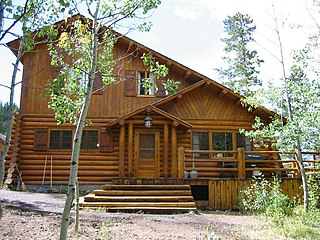
The Brinkerhoff is an historic lodge in Grand Teton National Park on the shore of Jackson Lake. It is the last remaining example of a forest lease vacation lodge in the park. The log house and caretaker's lodge were designed by architect Jan Wilking of Casper, Wyoming and were built in 1946 in what was then U.S. Forest Service land for the Brinkerhoff family. After the creation of Grand Teton National Park, the National Park Service acquired the property and used it for VIP housing. Among the guests at the Brinkerhoff were John F. Kennedy and Richard M. Nixon. The lodge is also notable as a post-war adaptation of the rustic style of architecture. The interior is an intact example of this transitional style.

The Jenny Lake Ranger Station Historic District comprises an area that was the main point of visitor contact in Grand Teton National Park from the 1930s to 1960. Located near Jenny Lake, the buildings are a mixture of purpose-built structures and existing buildings that were adapted for use by the National Park Service. The ranger station was built as a cabin by Lee Mangus north of Moose, Wyoming about 1925 and was moved and rebuilt around 1930 for Park Service use. A store was built by a concessioner, and comfort stations were built to Park Service standard plans. All buildings were planned to the prevailing National Park Service Rustic style, although the ranger station and the photo shop were built from parts of buildings located elsewhere in the park.

The Moraine Park Museum and Amphitheater, also known as the Moraine Park Lodge and the Moraine Park Visitor Center, are located in Moraine Park, a glaciated meadow between two moraines in Rocky Mountain National Park.

The Wilford H. Fawcett House is a house in Breezy Point, Minnesota, United States, listed on the National Register of Historic Places. Wilford H. Fawcett, also known as "Captain Billy", started the book "Captain Billy's Whiz Bang" as a joke book for soldiers during World War I. He formed Fawcett Publications in 1919 in Robbinsdale, Minnesota. In 1920, he bought a tract of land where the present-day Breezy Point Resort is located, and he began building cottages and a large log lodge. The lodge has since burnt down. He built the Fawcett House as a private residence within the resort property. Fawcett hired the Minneapolis architects of Magney and Tusler and commissioned the design in the Swiss Chateau style. The rustic log style was a bit ironic, since the local logging industry had declined before the resort was built. The house is located on a point on Breezy Point Bay on Big Pelican Lake. It has a "Y" shape. The center of the "Y" has a circular staircase leading to a "reading balcony" in the main hall. The building is constructed of peeled and trimmed Norway pine logs, with brown stain on the exterior and varnished on the interior. The center hall contains the "reading balcony", a large stone masonry fireplace, exposed logs for the rafter beams, and wrought iron fixtures. The remainder of the house has room for about 30 guests. In 1979, a fire damaged several rooms in the northwest wing, but the exterior was unharmed. While the interior has been modernized somewhat, it remains sympathetic to the original.
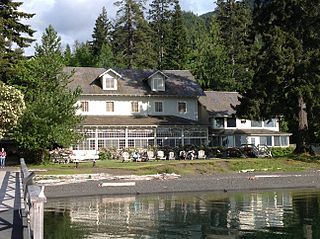
Lake Crescent Lodge, originally called Singer's Lake Crescent Tavern, is a historic resort situated on the shores of Lake Crescent west of Port Angeles, Washington. Located on the Olympic Peninsula within Olympic National Park, the Lodge is owned by the National Park Service and operated by Aramark. The Lodge resort is open seasonally from early May until the end of January with select cabins available during the winter months. Hiking and boating are popular activities for guests, and several peaks, including Mount Storm King and Pyramid Mountain, are easily accessible from the resort. Other hiking opportunities include Marymere Falls, Spruce Railroad, and Barnes Creek Trails.
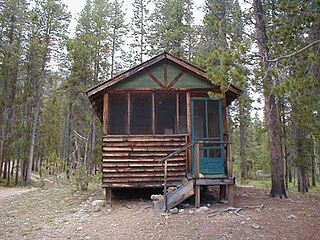
The Holzwarth Historic District comprises a series of cabins built by the Holzwarth family as a guest ranch inholding within the boundaries Rocky Mountain National Park, at Grand Lake, Colorado. The Holzwarths made their homestead in the Kawuneeche Valley in 1917, two years after the establishment of the park, and received a patent on the homestead in 1923. Guest ranch use began in 1919 and continued until the ranch was purchased by The Nature Conservancy in 1974. The property was transferred to the National Park Service in 1975 for incorporation into the park. The district comprises a number of rustic cabins on the Colorado River. Operations existed on both sides of the river, first known as the Holzwarth Trout Ranch and later as the Never Summer Ranch. All but Joe Fleshut's cabin have been removed from the east side of the river.

The Sunset Beach Hotel, also referred to as Peters' Sunset Beach Resort, is a historic resort hotel in Glenwood Township, Pope County, Minnesota, 5 miles (8.0 km) southwest of Glenwood, United States. Situated on the southern shore of Lake Minnewaska, three structures of the private, commercial resort were placed on the National Register of Historic Places (NRHP) on February 11, 1982. The complex is notable because it stands as one of the best-preserved early resorts in west central Minnesota, and as a center of seasonal resort activity on the lake since the second decade of the twentieth century.

Larson's Hunters Resort is a historic former hunting resort in Lake Valley Township, Minnesota, United States. It was in operation from the 1890s to the 1960s and became the best known hunting resort in Traverse County, while also being maintained as an active farm. Larson's Hunters Resort was listed on the National Register of Historic Places in 1985 for having local significance in the themes of architecture and commerce. As a historic district it consists of a prominent brick farmhouse/lodge built in 1901 and eight outbuildings. It was nominated for exemplifying the important hunting industry in west-central Minnesota and the phenomenon of farmer/resort owners, while the main building was further noted as the largest and most intact farmhouse in Traverse County, and one of the few constructed of brick.

The Brooks Lake Lodge, also known as the Brooks Lake Hotel and Diamond G Ranch, as well as the Two-Gwo-Tee Inn, is a recreational retreat in Fremont County, Wyoming near Dubois in the upper Wind River valley. The complex was built in 1922 to accommodate travelers coming to Yellowstone National Park on U.S. Route 287 from central Wyoming. The buildings are mainly of log construction with Craftsman style detailing.

The Twin Pines Lodge and Cabin Camp, also known as the Twin Pines Motel and Frontier Court, is a tourist camp near Dubois, Wyoming on the way to Yellowstone National Park on U.S. Route 287. The camp was established in 1929 by Dubois businessman Oliver Ernest Stringer who designed the camp and assisted in its construction. Stringer had previously been involved in the construction of the Brooks Lake Lodge, where he built furniture.

Gaffney's Lake Wilderness Lodge is a building on Lake Wilderness in Maple Valley, Washington. The lodge was built in 1950 and added to the National Register of Historic Places in 2003. Originally built for a destination resort on the lake, the lodge is currently operated by the City of Maple Valley.

